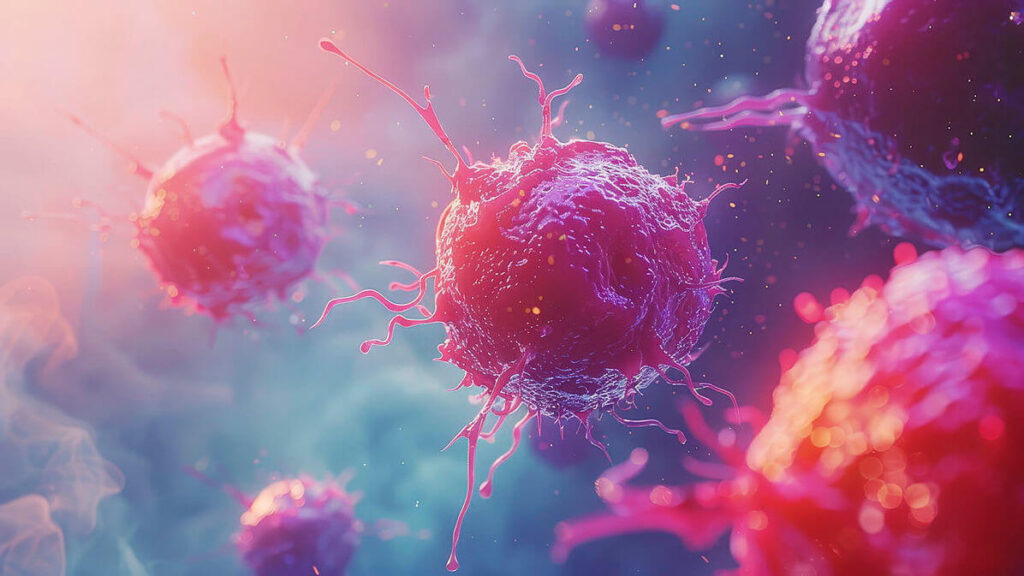medwireNews: A chimeric antigen receptor (CAR)-T cell therapy targeting both CD19 and CD20 has shown good tolerability and efficacy for the treatment of relapsed/refractory (R/R) large B-cell lymphoma (LBCL) in a phase 1b study.
“CD19 CAR-T cell therapies have transformed the treatment landscape for patients with relapsed/refractory large B-cell lymphoma; however, despite that, most patients do not achieve long-term remission,” observed Matthew Ku (St Vincent’s Hospital, University of Melbourne, Victoria, Australia) at the EAN2025 Congress in Milan, Italy.
He continued: “Relapses can occur due to a variety of causes, but one of the major issues is antigen escape from tumor cells, therefore dual targeting of two validated antigens on the malignant B-cells is a strategy that may protect against antigen escape as a resistance mechanism.”
The presenter explained to delegates that the bi-specific JNJ4496 (formerly C-CAR039) targets both CD19 via the mouse monoclonal antibody FMC63, and CD20 via a single chain fragment variant targeting two noncontiguous regions.
A total of 51 adults with R/R LBCL, who had not previously received CAR-T cell therapy, participated in the study. They underwent apheresis and 3 days of lymphodepletion (cyclophosphamide plus fludarabine), before being randomly assigned to one of three dosing regimens: a weight-based dose of 2 x 106 cells per kg; a fixed dose of 150 x 106 cells; or a fixed dose of 75 x 106 cells, which was the recommended phase 2 dose.
Bridging therapy was offered at the investigators’ discretion, and 67% of patients received this.
The participants had a median age of 72 years and 69% were men. Most (73%) had diffuse LBCL not otherwise specified (73%) and all had histologically confirmed CD19 and CD20 expression. In all, 39% of patients had received at least two lines of prior therapy, and 61% one line due to being ineligible for autologous stem cell transplant.
The patients had high-risk features, including primary refractory disease in over half (57%) of patients, bulky disease in 26%, an Internal Prognostic Index scores of 3 points or above in 29%, and Ann Arbor III or IV staging in 76%.
Safety was the primary outcome, with grade 3 or 4 adverse events (AEs) reported for 86% of all patients and 84% for the 25 patients receiving the recommended phase 2 JNJ4496 dose. Neutropenia and cytokine release syndrome (CRS) of any grade were the most common events, occurring in a respective 84% and 80% of all patients, and 76% and 88% of those receiving the recommended dose.
Ku highlighted that the majority of CRS cases were grade 1, at 53–68%, with only 4% of grade 3 or 4 in the full population, and none of grade 3 or 4 among the patients taking the recommended phase 2 dose. The median time to onset of CRS was 3 days and it lasted for a median of 5–6 days.
The rate of immune-effector cell-associated neurotoxicity syndrome (ICANS) was 16% for all patients and 8% for those receiving the recommended phase 2 dose, with a corresponding 8% and 4% of events grade 3 in severity. Onset occurred at a median of 3 days and the median duration was 17–22 days. All cases resolved without sequelae.
Of note, 28% of patients in the recommended phase 2 dose group reported a serious TEAE and all six deaths in the whole patient group, including three in the recommended dose group, were due to disease progression and unrelated to the study drug, commented Ku.
Treatment with JNJ4496 also led to a “high complete response [CR] rate,” a secondary objective, among the total 44 evaluable patients and the 22 receiving the recommended phase 2 dose, said Ku, and this was the case “irrespective of the number of prior lines of therapy.”
Specifically, over a median follow-up of 8 months, the overall response rate (ORR) for the whole patient group was 91%, and the ORR was 96% after a median 4-month follow-up for those receiving the recommended dose. The corresponding CR rates were 75% and 77%.
And among those receiving the recommended phase 2 dose, the ORRs for patients with one versus two or more prior lines of therapy were 100% and 92%, respectively, and the CR rates were 80% and 75%.
The median time to CR was 1 month in both the whole study population and those given the recommended phase 2 dose, with 87% and 79% achieving a CR duration of at least 3 months, respectively. A corresponding 10 and five patients in these groups experienced an improvement from a partial response to CR over follow-up.
Ku concluded that the findings “compare favorably to historical data with approved anti-CD19 CAR-T cell therapies,” and “support 75 million CAR-T cells as the recommended phase 2 dose of JNJ4496” in patients with R/R LBCL.


